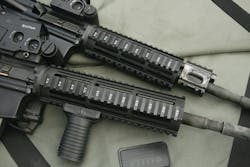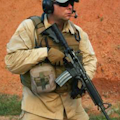The die has long since been cast and the Stoner-based carbine is now the patrol rifle of choice for U.S. law enforcement. That being the case, we need to get our troops out training with these guns if we expect them to have the confidence and ability to use them in a crisis.
While the .223 Remington cartridge, with the appropriate load, is vastly superior as a fight stopper when compared to a handgun, it also offers some challenges in training. First of all, training ammo for the .223 costs about twice as much as comparable training ammo for a sidearm. Also, we must take into account that many (not all, save your letters) indoor ranges and subsequently the target frames, carries, backstop etc. are set up for pistol calibers, not centerfire rifle.
Also, minimum safe distance when engaging reactive steel targets with handguns versus rifles are very different. Rifle grade steel is more expensive, heavier, and generally harder to come by than comparable pistol grade steel targets.
One solution is to purchase a couple, or a few, 9mm carbines that mimic the standard AR platform with the exception of the magazines. In this arena, CMMG, Inc. of Fayette, Missouri has you covered. During this review we’ll examine both 9x91mm and .223 Remington carbines from CMMG side by side.
CMMG Inc.
Presented for your consideration are M4 style carbines with sixteen inch barrels. One model chambers the 5.56mm/.223 Remington round and the other the 9x19mm round. Both have flat-top receivers, 4-way rail aluminum forearms, and retractable stocks.
The free-floating 5.56mm barrel has 1 in 7 right hand twist rifling. The 9mm version used 1 in 10 rifling. Both barrels were capped with a NATO-style birdcage flash suppressor. Also, each carbine used a Picatinny rail gas-block.
As for operation, the 5.56mm model was CMMG’s new gas-piston carbine and the 9mm version used a straight blowback, recoil operated mechanism. All external controls for both carbines were standard AR configuration including the bolt catch, magazine release button, manual safety lever and trigger.
The lower receivers on these guns varied in that the 5.56mm model was a standard AR configuration and was fed by all AR style magazines. The 9mm lower was a dedicated receiver, not a plugged or modified AR-type. Metalform 32 round stick magazines fed the 9mm carbine.
.223 Remington Ammo
Hornady has been offering their TAP (Tactical Application Police) defensive line for some time now and it has seen success in real world encounters. Featured herein would be their 60 grain TAP load chambered in .223 Remington. I would also use the Winchester USA white box 55grain FMJ load.
Benching the rifle, once I had the EOTech optic properly zeroed I put some test patterns down range. The resulting groups were predictably tight. A tight 1.17 inch three shot cluster at fifty yards proved the carbine and ammo combination could be counted on.
9x19mm Ammo
From the 9mm pistol ammunition side of house I chose the new Winchester PDX1 brand and the USA white box 115grain FMJ. The PDX load in question was a 147 grain bonded JHP. If this bullet looks familiar it is because the copper-colored projectile is the heart of Winchester’s Ranger L.E. ammunition line. Again, from fifty yards I fired several test groups on paper. The best group was right at 1.25 inches.
Training Benefits
Yes, you absolutely want to train people with the gear they are carrying. However, there is no getting around the fact that centerfire rifle training requires more specialized or dedicated facilities and targets.
I’ve trained all over the United States and finding and indoor range where centerfire rifles are permitted is difficult. Many training facilities will deal with the rifle situation by shooting only frangible projectile ammunition. That works but again, the cost of frangible rifle ammo mean high cost, therefore fewer rounds put down range.
Because the CMMG 9mm carbine mimic the .223 version almost completely, the shooter loses very little when switch to the pistol caliber over rifle for training scenarios. Comparing apple to apples, 9mm FMJ ammo costs about half that of .223 FMJ ammo. Twice as much trigger time, for half the cost, is a pretty good exchange in my book.
*Bonus Material
As a bonus for the readers, I took the controlled expansion ammunition from both calibers and tested them against barrier material backed up by ballistic test medium. Up first would be an interior wall façade. This barrier was built using two layers of half-inch sheet rock and a single layer of quarter-inch plywood. This would represent a standard interior wall construction, minus 2x4 studs. An additional portion of the “wall” would include two 2x4 boards combined with the original sheet rock and plywood construction.
Capturing the fired bullets would be accomplished through the construction of a bullet trap of sorts. This contraption was more of a rectangular trough made of wood with an open top. Into the bullet box I place thick squares of waxy ballistic media. This set up actually worked out better than I anticipated and will be repeated in future tests.
Loading all the guns, ammo, and target material up in the truck we drove to the range on a very pleasant afternoon. First up would be the 9mm carbine. Placing the wall board material in front of the bullet trap I took aim. From a distance of seven yards I fired a single round of the Winchester ammunition. The bullet passed completely through and entered the waxy media.
Step two was to fire the .223 cartridge from Hornady. Same scenario, shot through the wall board into the wax media at seven yards. On the outside of the wall board was an unimpressive .22 caliber hole. However, on the other side the results were a bit more spectacular. The projectile did its job very well and expanded violently. A hole nearly three inches across and as deep was left in the wax media.
Next on the agenda was to fire both carbines into the 2x4 and wall board material. This would represent nearly six inches of common building material found inside normal interior walls. Both the 9mm and .223 Remington rounds passed completely through.
Taking a moment to closely examine the bullet box, I pried apart the layers of wax media and found that the .223 TAP round had penetrated just shy of 8 inches. At that depth I discovered several bullet fragments. The projectile had come apart completely.
Moving on we found that the 9mm projectile had traveled a full 15 inches into the wax media after passing through the wall façade. It had not deformed and looked almost good enough to be reloaded. So much for the .223 will over-penetrate theory.
About the Author
Paul Markel
Mr. Markel is a former United States Marine, Police Officer, and has worked as a professional bodyguard both in the U.S. and overseas. A Subject Matter Expert on Small Arms and Tactics, Markel has provided instruction to law enforcement and U.S. Military troops.
As a recognized author and writer, Paul has penned several hundred articles published in numerous professional journals and trade periodicals. Topics include firearms training, use of force, marksmanship, less-than-lethal force options, product reviews and evaluations, emergency medical care, and much more. Sought after as a public speaker, Mr. Markel is at home in front of an audience large or small.
Follow Mr. Markel's instructional show: http://www.studentofthegun.com

